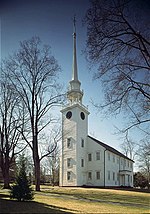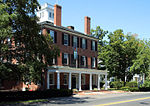Pequabuck Bridge
Bridges completed in 1832Bridges in Hartford County, ConnecticutFarmington, ConnecticutNational Register of Historic Places in Hartford County, ConnecticutRoad bridges on the National Register of Historic Places in Connecticut

The Pequabuck Bridge is a historic stone arch bridge, carrying a paved multiuse trail across the Pequabuck River in Farmington, Connecticut. Built in 1833, the bridge formerly carried the adjacent Meadow Road. It is one of the state's only surviving early 19th-century stone arch bridges and was listed on the National Register of Historic Places in 1984.
Excerpt from the Wikipedia article Pequabuck Bridge (License: CC BY-SA 3.0, Authors, Images).Pequabuck Bridge
Meadow Road,
Geographical coordinates (GPS) Address Nearby Places Show on map
Geographical coordinates (GPS)
| Latitude | Longitude |
|---|---|
| N 41.716694444444 ° | E -72.839777777778 ° |
Address
Meadow Road
06032
Connecticut, United States
Open on Google Maps









